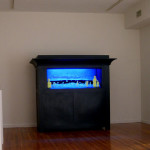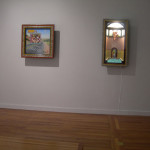By JAMES NADEAU
The Diorama. We've all made one or at the very least experienced one at some point in our lives. Arising out of the theatre in the mid 19th century, dioramas have grown both more complex and somewhat invisible culturally (museums being the most consistent users of the diorama today). Yet the diorama itself continues to fascinate whether it be in miniature or on the scale of the exhibits in the Museum of Natural History. They are simultaneously simulacra and fantasy spaces encapsulated within a box. Dioramas operate as liminal spaces, enabling us to project or imagine ourselves into them; constructions that are both confined in their very nature yet unbelievably open in their possibilities. Originally operating as a theatrical space in miniature offering viewers a landscape painting that would change over the course of time, today's notions of the diorama are shaped by the success and popularity of the work ofJoseph Cornell (this despite the fact that Cornell's work was arguably more about the assemblage than the diorama). Regardless of what one considers to be a true "diorama" they offer an interesting mode of investigation for artists. They are ever-present in our culture while retaining their association with childhood and the act of playing. Perhaps that is why they are so interesting to come across when used as an art form?
Boston CyberArts Festival founder George Fifield and Axiom Gallery Co-Director Phaedra Shanbaum have gathered together a group of artists making work that are best described as dioramas. The pieces operate as sculpture, multi-media, holograms and interactive mechanisms. The show titled "Inside the Box" offers up the opportunity to see the varied possibilities inherent in using the diorama as an art form. This is both its greatest strength and its weakness. The breadth is exciting to see yet at the same time is annoying in its inconsistency. Some of the work is quite strong. Jerry Williams' work pulls you in and fascinates with its exacting sculptural elements. The figures are fully realized and the use of the depth provided by the framed space engage the eye with a strength that is hard to top. They felt, at times, like a Harvey Kurtzman drawing realized in 3D. It is really the robustness of Williams' work that diminishes the power of the other pieces. Anthony Flackett's work, while visually and technically engaging, unfortunately comes across as intellectually limited.
Using projection within the space of the diorama Flackett's work is a great example of the possibilities that multi-media offer to the re-thinking and re-imagining of the diorama. The pieces bring to mind Kino-scopes of the early twentieth century in their construction and (to their disservice) the narratives constructed within are reminiscent of those early kinos as well. If that was the intent, then job well done. But it was disappointing. Robert Taplin's work was quite interesting and to some extent seemed the most traditional of the dioramas in the show. The large black box dominated the gallery yet drew one into its space with his dramatic use of colour and depth of field. It had an eeriness that wasn't present in the other work. The show also includes work from Susie Silver & Hillary Harp, Allison Holt and Empire S.N.A.F.U. Silver and Harp do a rather nice job inserting LCD video monitors into their dioramas. But with the side effect being that the limitations of the technology made the video somewhat difficult to discern.
All in all the show itself is quite interesting and George and Phaedra should be commended for bringing technically difficult work into the gallery space. The downside being that the success of this kind of show hinges on a uniformity that is difficult to attain. Ultimately some pieces will engage and others won't. Shows that are predicated upon art outside of traditional forms lack a consistency. A drawing or painting exhibitions secure this because they are familiar. That is the challenge here. Is the diorama strong enough a concept to bring the show together? I left the gallery not so sure of that.
- Three installation views of “Inside The Box”
"Inside The Box" is on view January 4 - February 5, 2008 at Howard Yezerski Gallery.
All images are courtesy of the artist and Howard Yezerski Gallery.







